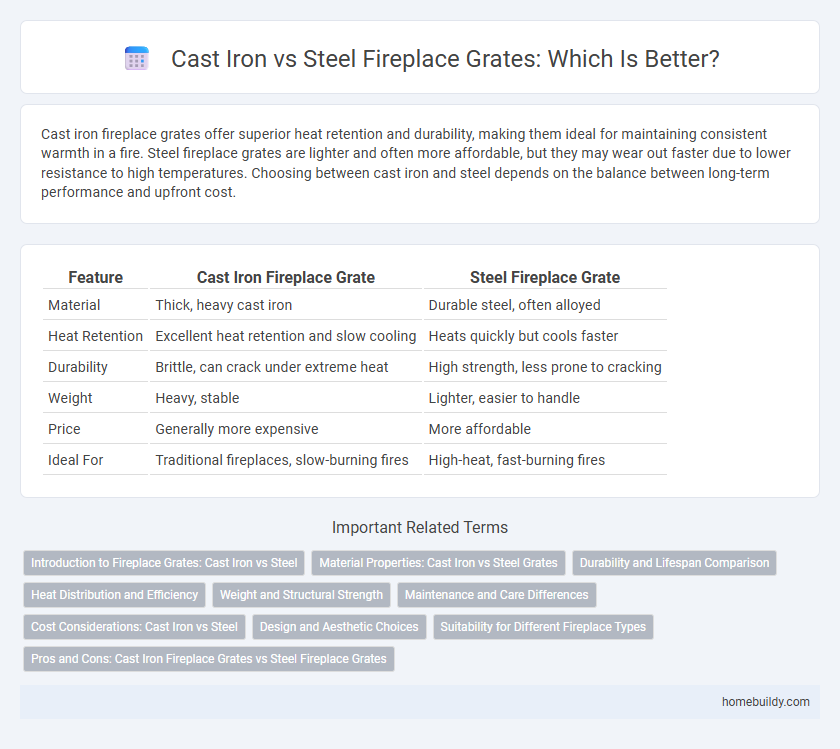Cast iron fireplace grates offer superior heat retention and durability, making them ideal for maintaining consistent warmth in a fire. Steel fireplace grates are lighter and often more affordable, but they may wear out faster due to lower resistance to high temperatures. Choosing between cast iron and steel depends on the balance between long-term performance and upfront cost.
Table of Comparison
| Feature | Cast Iron Fireplace Grate | Steel Fireplace Grate |
|---|---|---|
| Material | Thick, heavy cast iron | Durable steel, often alloyed |
| Heat Retention | Excellent heat retention and slow cooling | Heats quickly but cools faster |
| Durability | Brittle, can crack under extreme heat | High strength, less prone to cracking |
| Weight | Heavy, stable | Lighter, easier to handle |
| Price | Generally more expensive | More affordable |
| Ideal For | Traditional fireplaces, slow-burning fires | High-heat, fast-burning fires |
Introduction to Fireplace Grates: Cast Iron vs Steel
Cast iron fireplace grates offer exceptional heat retention and durability, making them ideal for long-lasting fires in traditional wood-burning fireplaces. Steel fireplace grates provide a lighter, more affordable option with superior resistance to warping under high temperatures, suitable for frequent use and modern fireplace designs. Both materials influence combustion efficiency and fire safety, shaping the overall fireplace experience.
Material Properties: Cast Iron vs Steel Grates
Cast iron fireplace grates offer exceptional heat retention and a classic aesthetic, making them ideal for consistent warmth and traditional settings. Steel fireplace grates, being lighter and more flexible, provide superior durability and resistance to warping under high temperatures. The choice between cast iron and steel grates depends on whether heat storage or structural resilience is prioritized in the fireplace design.
Durability and Lifespan Comparison
Cast iron fireplace grates offer exceptional durability due to their high resistance to heat and wear, often lasting several decades with proper care. Steel fireplace grates, while initially more affordable and lighter, tend to warp or corrode faster under intense heat, resulting in a shorter lifespan typically around 5 to 10 years. Choosing cast iron ensures extended longevity and consistent performance in high-temperature environments.
Heat Distribution and Efficiency
Cast iron fireplace grates provide superior heat retention and distribute warmth evenly due to their dense structure, enhancing overall heating efficiency. Steel fireplace grates heat up faster but cool down quickly, making them less effective in maintaining consistent heat over time. Choosing cast iron improves sustained heat output while steel offers quicker initial heat but reduced long-term warmth.
Weight and Structural Strength
Cast iron fireplace grates offer superior weight and structural strength, providing durable support for heavy logs and long-lasting performance under intense heat. Steel fireplace grates are generally lighter yet maintain excellent tensile strength, making them easier to handle and resistant to warping from thermal expansion. Choosing between cast iron and steel depends on prioritizing maximum longevity and weight-bearing capacity versus lighter construction and flexibility.
Maintenance and Care Differences
Cast iron fireplace grates require regular seasoning and rust prevention treatments to maintain their durability and prevent cracking over time, as they are prone to rust. Steel fireplace grates offer easier maintenance with higher resistance to corrosion and less frequent need for protective coatings, making them more suitable for wet or humid environments. Both materials benefit from routine cleaning of ash and debris to ensure efficient airflow and prolonged lifespan.
Cost Considerations: Cast Iron vs Steel
Cast iron fireplace grates typically have a higher initial cost due to their heavy, durable material and intricate manufacturing process, but their longevity can make them cost-effective over time. Steel fireplace grates are generally more affordable upfront and offer good heat tolerance but may require more frequent replacement due to potential warping or rust. Evaluating long-term durability against initial expenses helps determine the best cost option between cast iron and steel grates.
Design and Aesthetic Choices
Cast iron fireplace grates offer a classic, ornate design with intricate detailing that enhances traditional hearth aesthetics, while steel grates feature sleek, minimalist lines suited for modern interiors. The weight and texture of cast iron provide a rustic, vintage look, contrasting with the lightweight, polished finish of steel that complements contemporary decor. Selecting between cast iron and steel grates depends largely on the desired visual impact and consistency with overall fireplace and room design.
Suitability for Different Fireplace Types
Cast iron fireplace grates are ideal for traditional masonry fireplaces due to their superior heat retention and durability under high temperatures, providing consistent warmth and long-lasting support for heavy wood logs. Steel fireplace grates, being lighter and more flexible, are better suited for modern, prefabricated fireplaces where rapid heat conduction and easy handling are advantageous, ensuring efficient burning and ease of maintenance. Selecting the appropriate material enhances fuel efficiency and prolongs the lifespan of both the grate and the fireplace structure.
Pros and Cons: Cast Iron Fireplace Grates vs Steel Fireplace Grates
Cast iron fireplace grates offer excellent heat retention and durability, making them ideal for long-lasting fires but tend to be heavier and more brittle, risking cracks under severe temperature changes. Steel fireplace grates are lighter, more flexible, and typically resistant to warping, providing easier handling and better performance under high heat but may rust over time if not properly maintained. Choosing between cast iron and steel grates depends on balancing heat conduction needs, weight preferences, and resistance to wear and corrosion.
Cast iron fireplace grate vs Steel fireplace grate Infographic

 homebuildy.com
homebuildy.com